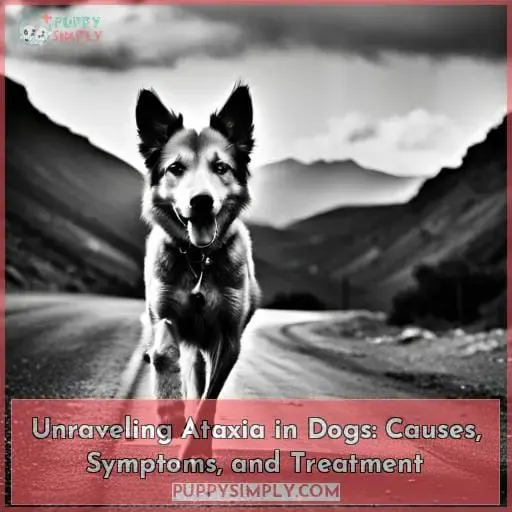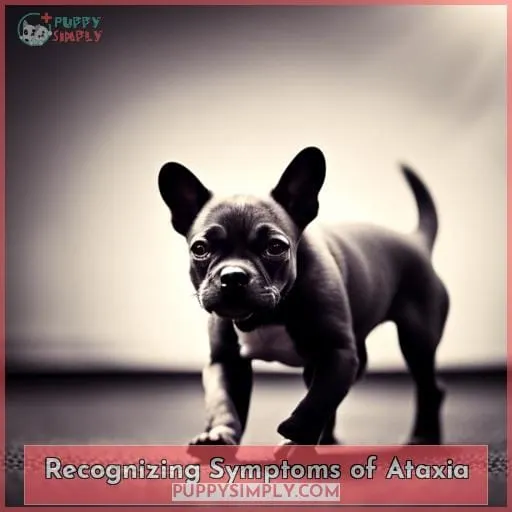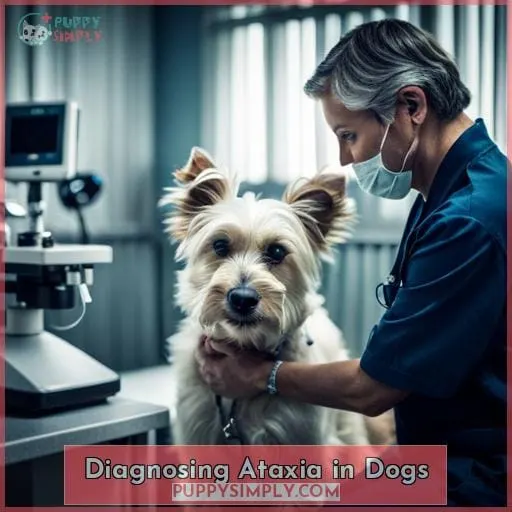This site is supported by our readers. We may earn a commission, at no cost to you, if you purchase through links.
 Do you notice your dog losing coordination, stumbling, or falling?
Do you notice your dog losing coordination, stumbling, or falling?
These may be signs of ataxia, a neurological condition that affects balance and coordination.
While ataxia can be caused by other conditions, it often points to an underlying neurological issue.
Recognizing the symptoms and seeking prompt veterinary attention is crucial for managing ataxia and ensuring your dog’s well-being.
Table Of Contents
- Key Takeaways
- What is Ataxia?
- Recognizing Symptoms of Ataxia
- Diagnosing Ataxia in Dogs
- Treating Ataxia in Dogs
- Ensuring Pet Comfort and Well-being
- When Should I Call My Veterinarian?
- Frequently Asked Questions (FAQs)
- How can I differentiate between ataxia and other conditions that cause similar symptoms, such as weakness or lameness?
- Are there any specific breeds or ages of dogs that are more prone to developing ataxia?
- How can I prevent my dog from developing ataxia, and are there any lifestyle or dietary changes I can make to reduce the risk?
- What is the long-term prognosis for dogs with ataxia, and how can I manage their condition over time to ensure their quality of life?
- Are there any complementary therapies or alternative treatments that have been shown to be effective in managing ataxia in dogs?
- Conclusion
Key Takeaways
- Ataxia is a neurological condition affecting voluntary muscle movements in dogs due to cerebellar problems.
- Symptoms vary depending on the specific area of the cerebellum affected, including exaggerated limb movements, difficulty coordinating muscle movements, and balance issues.
- Diagnosis involves a neurological exam, imaging tests, and bloodwork analysis. Treatment depends on the underlying cause and can include medication, physical therapy, surgery, and supportive care.
- Ensuring pet comfort and well-being involves creating a safe environment, providing daily activity assistance, and monitoring the condition closely.
What is Ataxia?
In dogs, ataxia is a neurological condition that affects voluntary muscle movements due to problems with the cerebellum, the brain region responsible for coordination and balance. This disruption in neural communication leads to an array of clinical signs, collectively known as ataxia.
Ataxia can manifest in various forms, depending on the specific area of the cerebellum affected.
- Cerebellar ataxia, the most common type, causes exaggerated limb movements, head tremors, and an unsteady gait.
- Proprioceptive ataxia, which involves impaired awareness of body position, results in stumbling, dragging of paws, and difficulty maintaining balance.
- Vestibular ataxia, stemming from dysfunction in the inner ear or brainstem, leads to head tilting, circling, and impaired balance.
The underlying causes of ataxia in dogs are diverse, ranging from genetic predisposition and environmental factors to infectious diseases and metabolic disorders. Identifying the root cause is crucial for determining the most appropriate treatment approach.
Recognizing Symptoms of Ataxia
As we delve into the subtopic of recognizing ataxia symptoms, let’s first differentiate between cerebellar, proprioceptive, and vestibular ataxia:
Cerebellar ataxia:
- Exaggerated limb movements
- Head tremors
- Difficulty coordinating voluntary muscle movements
Proprioceptive ataxia:
- Stumbling
- Dragging toes
- Inability to gauge limb and body placement
Vestibular ataxia:
- Head tilting
- Circling
- Balance issues due to problems in the brainstem or inner ear
Cerebellar Ataxia
You’ll notice goose-stepping, head tremors, and legs flying in different directions if your dog has cerebellar ataxia.
Frequent loss of balance and dragging toes are also common signs.
Cerebellar degeneration can be caused by genetic predisposition or breed susceptibility.
Treatment options and prognosis evaluation depend on the underlying cause.
Proprioceptive Ataxia
Next, you’ll learn about proprioceptive ataxia:
- Your dog may stumble, drag its toes, sway, and have its paws bend under while walking.
- This type of ataxia stems from spinal cord compression, leading to wobbly gait, difficulty determining limb placement, and awkward movements.
- Weakness in the limbs is also a common sign.
| Symptom | Description | Cause |
|---|---|---|
| Stumbling | Loss of coordination in the legs | Spinal cord compression |
| Dragging toes | Inability to lift paws properly | Nerve damage |
| Swaying | Difficulty maintaining balance | Proprioceptive deficits |
| Paws bending under | Weakness in the limbs | Spinal cord disease |
Vestibular Ataxia
Vestibular ataxia, a subtype of ataxia, disrupts your dog’s sense of balance.
This leads to a tilted head, uncoordinated gait, and circling movements.
Dizziness, vomiting, and eye fluttering accompany this condition.
It is often caused by inner ear or brainstem issues.
Geriatric vestibular disease, middle ear infections, and certain medications can trigger these symptoms.
Diagnosing Ataxia in Dogs
Now that you’re familiar with ataxia’s diverse symptoms, let’s delve into the diagnostic process.
Your veterinarian will embark on a thorough neurological exam, meticulously assessing your dog’s coordination, reflexes, and posture.
Next, they may recommend imaging tests to visualize your dog’s brain and spinal cord. These tests can reveal structural abnormalities, such as tumors or degenerative changes, that might be causing the ataxia.
Bloodwork analysis can also provide valuable clues, helping to identify underlying infections or metabolic disorders.
In some cases, your veterinarian may suggest consulting a specialist, such as a veterinary neurologist, for further expertise and advanced diagnostic procedures.
This collaboration ensures that your dog receives the most accurate diagnosis and appropriate treatment plan.
Treating Ataxia in Dogs
Depending on the cause of your dog’s ataxia, your veterinarian may recommend:
- Medication to manage symptoms like seizures, inflammation, or pain.
- Physical therapy to improve balance, coordination, and muscle strength.
- Surgery to correct spinal cord abnormalities or remove tumors.
Supportive care is crucial to ensure your dog’s comfort and well-being. This may include:
- Providing a safe and comfortable environment.
- Assisting with daily activities.
- Monitoring their condition closely.
The prognosis for dogs with ataxia varies widely depending on:
- The underlying cause.
- The severity of the condition.
- The response to treatment.
Some conditions may be treatable, while others may be progressive and incurable. Your veterinarian will work with you to develop a treatment plan that aims to improve your dog’s quality of life and manage their symptoms effectively.
Ensuring Pet Comfort and Well-being
With ataxia treatment underway, focus on your dog’s comfort and well-being by creating a safe environment.
Secure your home by:
- Blocking sharp corners
- Laying down non-slip mats
- Installing ramps or stairs to aid mobility
Adapt the home layout to minimize obstacles.
Provide a supportive harness or sling for walking assistance.
Ensure a nutritious diet tailored to your dog’s condition.
Regular exercise, within their capabilities, helps maintain muscle strength.
Monitor their condition closely, and consult your veterinarian for ongoing support.
As the disease progresses, pain management and end-of-life decisions may arise.
When Should I Call My Veterinarian?
Pet owners should contact their veterinarian immediately if they notice any signs of ataxia, such as stumbling, head tilting, or uncoordinated gait, in their dog.
These symptoms could indicate an underlying neurological issue that requires prompt attention. Even subtle changes in your dog’s balance or coordination warrant a veterinary visit.
Regular checkups are crucial for early detection and intervention, especially if your dog is prone to ataxia due to breed or age.
Your veterinarian can provide personalized advice on managing your dog’s condition and recommend supportive care measures to improve their quality of life.
In emergency situations, such as sudden onset of severe ataxia, difficulty breathing, or seizures, seek immediate veterinary care.
These symptoms may indicate a life-threatening condition that requires urgent treatment.
Don’t hesitate to reach out to your veterinarian with any concerns or questions regarding your dog’s ataxia. Their expertise and guidance will help you navigate this challenging condition and ensure your furry friend receives the best possible care.
Frequently Asked Questions (FAQs)
How can I differentiate between ataxia and other conditions that cause similar symptoms, such as weakness or lameness?
Distinguishing ataxia from similar conditions demands a keen eye for neurological nuances.
Look beyond weakness or lameness to subtler signs like:
- Wobbly gait
- Head tilt
- Impaired coordination
These clues help unravel the neurological puzzle.
Are there any specific breeds or ages of dogs that are more prone to developing ataxia?
Certain breeds, such as Russell terriers, may have a genetic predisposition to cerebellar ataxia.
Age can also play a role, with some ataxias more common in older dogs due to degenerative changes in the nervous system.
How can I prevent my dog from developing ataxia, and are there any lifestyle or dietary changes I can make to reduce the risk?
Preventing ataxia in dogs solely through lifestyle or dietary changes is challenging, as it’s often caused by underlying medical conditions.
Regular veterinary checkups and early intervention for treatable causes are crucial for reducing the risk and ensuring your dog’s well-being.
What is the long-term prognosis for dogs with ataxia, and how can I manage their condition over time to ensure their quality of life?
Like a ship lost at sea,
dogs with ataxia navigate life’s currents with uncertainty.
Long-term, their journey depends on the underlying cause,
but with diligent care,
you can be their guiding star,
ensuring their voyage is filled with comfort and love.
Are there any complementary therapies or alternative treatments that have been shown to be effective in managing ataxia in dogs?
Exploring complementary therapies for ataxia management in your dog can offer additional support.
Discuss acupuncture, physical rehabilitation, and herbal remedies with your veterinarian to determine a holistic approach that complements conventional treatment.
Conclusion
Isn’t it ironic how our canine companions, known for their impeccable grace and agility, can suddenly stumble and falter?
Ataxia, the neurological culprit behind this unsteadiness, demands your attention.
Ignoring its symptoms is like turning a blind eye to a flashing red light.
Seek veterinary guidance promptly, and together, you’ll navigate the complexities of ataxia, ensuring your furry friend regains their steady paws and playful spirit.












